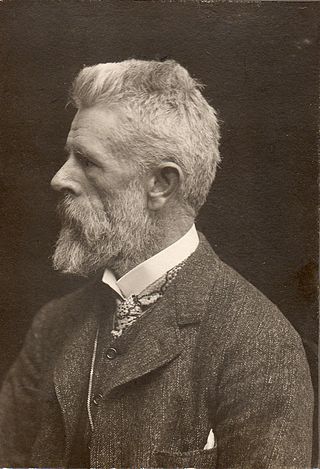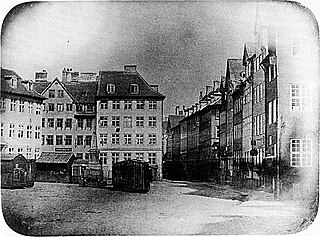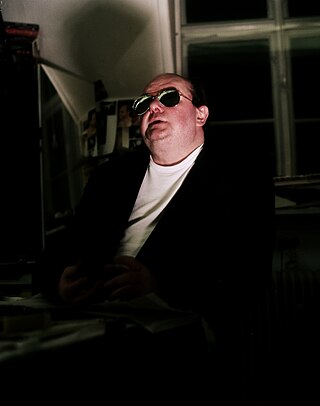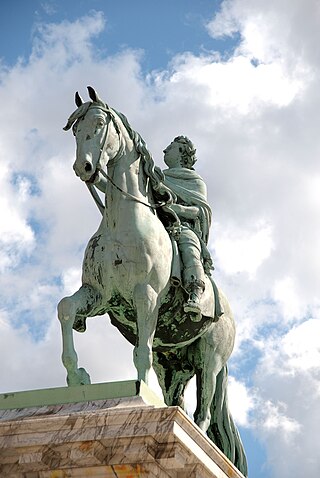Related Research Articles

Jacob Christian Jacobsen, mostly known as J. C. Jacobsen, was a Danish industrialist and philanthropist best known for founding the brewery Carlsberg.

Trold, der vejrer kristenblod is a bronze sculpture made by Niels Hansen Jacobsen (1861–1941).

Ann Lislegaard is a contemporary artist living and working in Copenhagen, Denmark and New York City, US. She is known for her 3D film animations and sound-light installations often departing from ideas found in science fiction. She finds in Science fiction an alternative approach to language, narration, gender roles and concepts of the future.

Laurits Regner Tuxen was a Danish painter and sculptor specialising in figure painting. He was also associated with the Skagen Painters. He was the first head of Kunstnernes Frie Studieskoler, an art school established in the 1880s to provide an alternative to the education offered by the Royal Danish Academy of Fine Arts.

Jens Vilhelm Dahlerup was a Danish architect who specialized in the Historicist style. One of the most productive and noted Danish architects of the 19th century, he is behind many of the most known buildings and landmarks of his time and has more than any other single architect contributed to the way Copenhagen appears today.

Richard Ludvig Philip Weibull Winther was a Danish artist. He focused on painting, graphics, photography and sculpture. Richard's work was influenced by Asger Jorn and Richard Mortensen, both Danish artists part of the Linien group.

In Denmark, photography has developed from strong participation and interest in the very beginnings of the art in 1839 to the success of a considerable number of Danes in the world of photography today.
Morten Bo, is a Danish photographer who specializes in documentary work with a social impact. His 15 travelling exhibitions in the 1970s and 1980s stirred up controversy. In the 1980s, he turned to abstract photography with lines, contours and contrasts of light and shade. A member of Delta-Photos from 1967 to 1972, in 1973, he was a co-founder of the Ragnarok group. In line with his interest in promoting the art, he founded Fatamorgana, Denmark's school of art photography, in 1989.
Astrid Kruse Jensen is a Danish photographer and visual artist. She studied at the Gerrit Rietveld Academie in the Netherlands and the Glasgow School of Art in Scotland. Her artistic work is often characterized by its dreamy qualities, blurring the boundaries between memory, consciousness, reality, and illusion.
Trine Søndergaard, is a Danish photography-based visual artist. Trine Søndergaard lives and works in Copenhagen, Denmark.
Nicolai Howalt is a Danish visual artist and contemporary photographer.

Frans Kannik was educated in Serigraph in 1968. He also studied calligraphy in Oslo between 1971 and 1974. As an artist, he was generally self-educated. He was a multifaceted artist that expressed in a wide range of paintings, graphics, installation art, performance arts and sculptures.

Danish sculpture as a nationally recognized art form can be traced back to 1752 when Jacques Saly was commissioned to execute a statue of King Frederick V of Denmark on horseback. While Bertel Thorvaldsen was undoubtedly the country's most prominent contributor, many other players have produced fine work, especially in the areas of Neoclassicism, Realism, and in Historicism, the latter resulting from growing consciousness of a national identity. More recently, Danish sculpture has been inspired by European trends, especially those from Paris, including Surrealism and Modernism.

Jørgen Haugen Sørensen was one of Denmark's most eminent sculptors. He had his artistic debut at the acclaimed and prestigious Spring Exhibition (Forårsudstillingen) at Kunsthal Charlottenborg, Copenhagen in 1953. Haugen Sørensen was a member of the artistic union Decembristerne and the artist collective Grønningen, as well as Veksølund in Denmark.
Eva Louise Buus is a Danish artist. A graduate of the Royal Danish Academy of Fine Arts, she has exhibited in Denmark, Germany and Greenland. Her landscapes are principally concerned with the effects of light and darkness on the appearance of her images. In 2015, she exhibited works in Fanø Museum which she had created by subjecting plates of copper to the effects of various acids, inspired by the landscapes of the Swedish painter Carl Johan Forsberg. More recently her metallic works have drawn on his recently rediscovered watercolours of women.
Christian Lemmerz is a German-Danish sculptor and visual artist who attended the Accademia di Belle Arti in Carrara, Italy, from 1978 to 1982 and the Royal Danish Academy of Fine Arts from 1983 to 1988. Despite classical sculpture training in Carrara, Lemmerz drew his main inspiration from the post-war process-oriented pop art, not least from his fellow countryman, Joseph Beuys.
Lene Adler Petersen is a Danish artist. Her artistic practice is characterized through a continuous collecting, sorting and mixing process of media and techniques and includes happenings and performance art as well as painting, ceramics, drawings, printmaking and installations, film and photography.
Sophia Kalkau is a Danish artist, who works in a variety of media including writing, photography, sculpture and installation. Sophia Kalkau has studied Art History at Copenhagen University and holds a degree in Art Theory from the Royal Danish Academy of Fine Arts. She is the author of numerous publications on aesthetics.
Berit Heggenhougen-Jensen is a Danish artist who played a central role in the Danish Wild Youth artistic trend in the 1980s. She gained recognition from her participation in the 1982 exhibition Kniven på hovedet held at Tranegården in Gentofte.
Erik August Frandsen is a Danish contemporary artist. In the early 1980s Erik A. Frandsen was part of the artistic movement de unge vilde and in 1981, he co-founded the artist collective Værkstedet Værst with prominent working with artists such as Lars Nørgård and Christian Lemmerz. He currently works from studios in Copenhagen, Nordfalster and Como, Italy.
References
- ↑ "Per Bak Jensen", Den store Danske. Retrieved 24 February 2010. (in Danish)
- ↑ "Per Bak Jensen - Genkomst" Archived 2012-03-03 at the Wayback Machine , FagBogInfo. Retrieved 23 February 2010. (in Danish)
- ↑ "Per Bak Jensen. Interview", KunstOnline. Retrieved 24 February 2010. (in Danish)
- 1 2 "Per Bak Jensen", Kunstindeks Danmark. Retrieved 25 February 2010. (in Danish)
- 1 2 3 Rune Gade, "Et solidt fundament", in Dansk Fotografi Historie, ed. Mette Sandbye (Copenhagen: Gyldendal, 2004), p. 402 et seq. ISBN 87-00-39586-2.
- ↑ "Per Bak Jensen", Kunst.dk Archived 2011-07-19 at the Wayback Machine . Retrieved 24 February 2010. (in Danish)